Headphones evolved from early telephone technology in the 1880s, with the first commercial application appearing through London’s Electrophone system in 1894. The first modern headphones were created by Nathaniel Baldwin in 1910, initially adopted by the U.S. Navy. World War I accelerated development as military applications demanded better sound isolation. John Koss revolutionized consumer headphones in 1958 with the first stereo model, setting the foundation for today’s wireless, noise-canceling, and specialized designs that continue this audio evolution.
Key Takeaways
- Headphones originated in the 1880s-1890s through telephone technology developments and the Electrophone system.
- Nathaniel Baldwin created the first modern headphones in 1910, initially selling them to the U.S. Navy.
- John Koss revolutionized audio with the first stereo headphones (SP/3) in 1958, enabling distinct left-right channel listening.
- Military applications during World War I accelerated headphone development for communications and enemy aircraft detection.
- Technological innovations expanded from the 1980s-2000s with noise-canceling technology, Bluetooth connectivity, and wireless capabilities.
The Birth of Audio Technology: From Telegraph to Telephone (1880s)
During the late 19th century, audio technology underwent a revolutionary transformation that would eventually lead to the development of headphones. Telegraph advancements established the foundation for audio transmission systems, dominating communication from the 1830s through the 1860s.
Alexander Graham Bell’s telephone patent in 1876 marked a pivotal shift in sound technology. By 1877, the first telephone lines and exchanges were established, with Siemens contributing to early commercialization in Berlin. Telephone prototypes rapidly evolved when Emile Berliner invented an improved transmitter that same year, greatly enhancing audio quality.
The technology expanded quickly, with the first commercial US telephone exchange opening in New Haven, Connecticut, in January 1878. This period of innovation established essential audio transmission principles that would later become fundamental to headphone development.
The First True Headphones: Electrophone’s Theater Listening System (1890s)
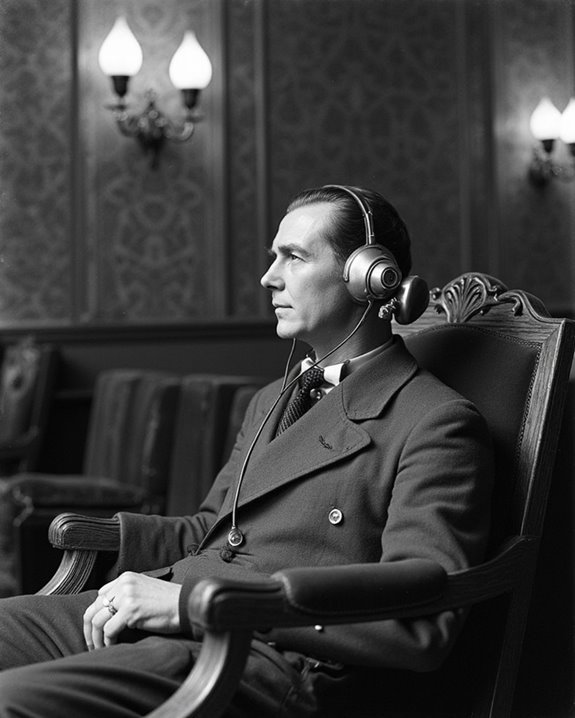
By the late 1890s, the first true headphone system emerged in the form of the Electrophone, a revolutionary technology that transmitted live audio from theaters and churches directly into subscribers’ homes. Founded in 1894 by H.S.J. Booth, the Electrophone Company operated through the existing telephone network infrastructure.
For an annual fee of £5, affluent subscribers—including Queen Victoria—could access Theater Subscriptions featuring performances from fourteen London venues. The system utilized carbon microphones strategically placed to capture audio, which was then routed through a manual switchboard at Pelican House.
Sunday Church Broadcasts became particularly popular, with microphones disguised as bibles in fifteen London churches. This pioneering audio streaming service represented the first commercial application of headphone technology, predating modern live streaming services by nearly a century.
Nathaniel Baldwin’s Kitchen-Made Revolution (1910)
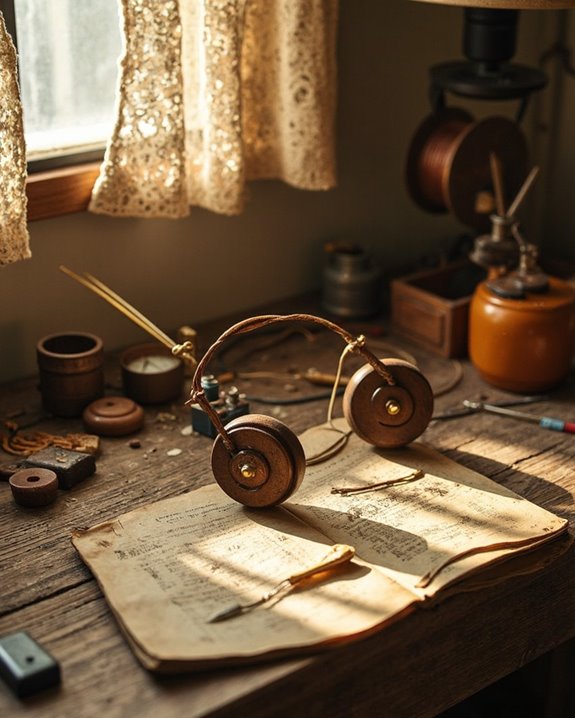
The year 1910 marked a pivotal moment in audio technology when Nathaniel Baldwin created the first modern headphones at his kitchen table in Utah. His Kitchen Inspiration came after struggling to hear speakers at a church conference, prompting him to develop a device that could amplify sound while isolating background noise.
Despite the revolutionary design, Baldwin faced significant Investor Setbacks when private financiers showed little interest in his invention. Undeterred, he offered his handmade headphones to the U.S. Navy for testing. The military quickly recognized their superior performance over existing technology and placed an initial order for ten units.
Baldwin’s innovation featured a headset assembly with specialized earpieces that established the fundamental design elements still present in contemporary headphones, cementing his legacy in audio technology history.
World War I and Military Adoption of Headphone Technology
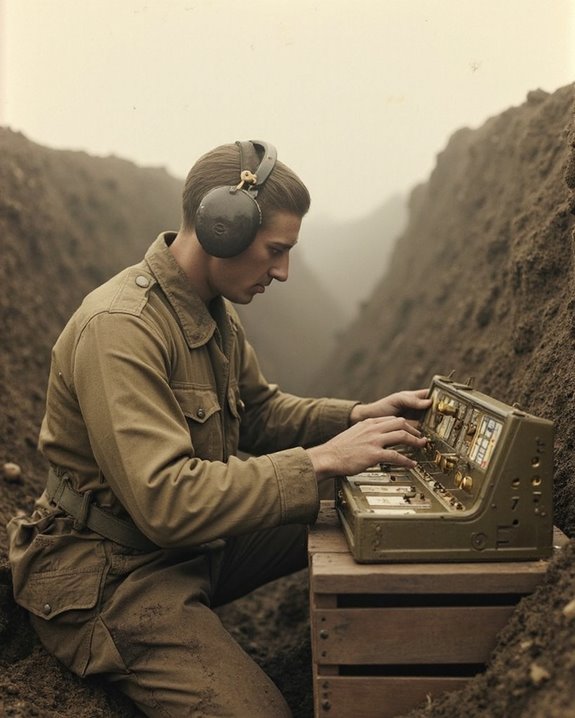
As World War I erupted across Europe in 1914, headphone technology transformed from nascent consumer curiosity to essential military tool. Military operations demanded reliable audio equipment for wartime espionage and communications.
Sound localization became critical for defense strategies, with operators wearing headphones connected to large horn-shaped collectors to detect approaching enemy aircraft. These systems, resembling primitive radar, allowed for artillery spotting and strategic positioning of anti-aircraft weapons.
Headphones were integrated with mechanical computers and Barr and Stroud height finders, enabling precise triangulation of enemy positions. The technology evolved from rudimentary stethoscope-like devices to more durable designs suitable for battlefield conditions.
This military adoption accelerated headphone development globally, as nations competed to create superior sound detection systems, ultimately influencing post-war telecommunications advancements in both military and civilian sectors.
The Evolution of Comfort: Design Innovations From 1920-1950
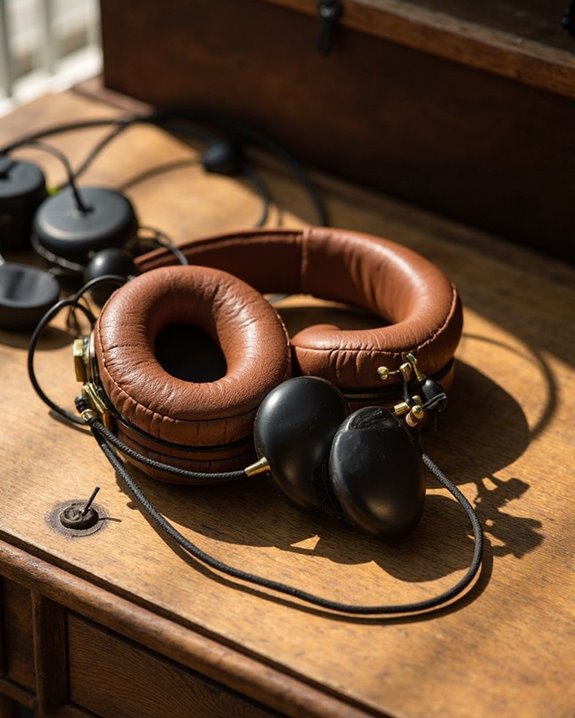
Following World War I, headphone design underwent dramatic transformation as manufacturers shifted focus from pure functionality toward user comfort and ergonomics. Early 1920s headphones featured rigid metal headbands and minimal cushioning, causing discomfort during extended use.
Significant Comfort Innovations emerged by mid-decade with the introduction of leather padding and adjustable headbands. This period saw manufacturers experimenting with lighter materials and ergonomic ear cup shapes that better conformed to human anatomy.
The 1930s-40s brought further Ergonomic Developments through flexible headbands, improved cushioning materials like foam rubber, and pivoting ear cups that aligned better with users’ ears. By the late 1940s, companies like Koss pioneered consumer-oriented designs featuring larger ear cups, softer padding, and balanced weight distribution—innovations that would define headphone comfort for decades to come.
From Professional Tools to Consumer Products: The Mid-Century Shift
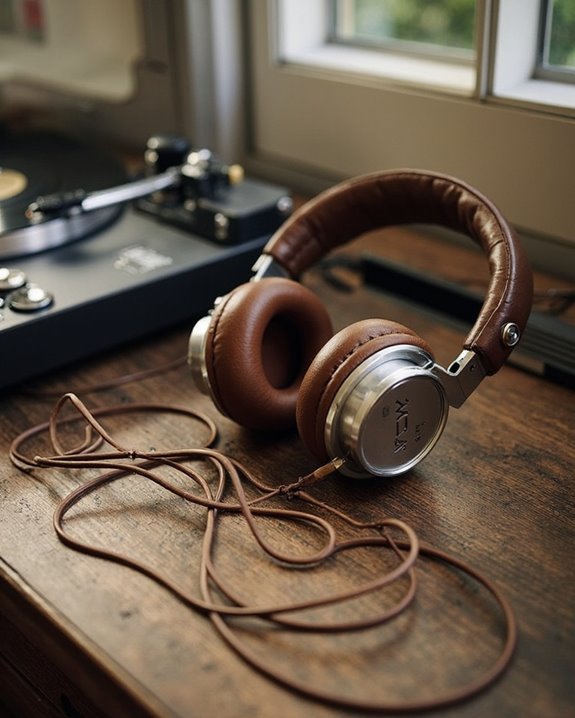
During the mid-century period, headphones underwent a dramatic transformation from specialized professional tools to widespread consumer products. John Koss’s introduction of the SP/3 stereo headphones in 1958 marked a pivotal moment in this evolution, enabling consumers to experience distinct left and right audio channels for the first time.
This technological advancement coincided with significant Consumer Appeal as headphones became essential components of home stereo systems in the 1960s and 1970s. Improved materials and transistor technology allowed for smaller, more comfortable, and higher-quality listening devices.
The Cultural Shift was equally profound as headphones facilitated private listening in shared spaces, fundamentally changing how people experienced music. This shift from utility to lifestyle accessory established headphones as a staple in consumer electronics, forever altering personal audio consumption.
The Emergence of Different Headphone Styles and Their Applications
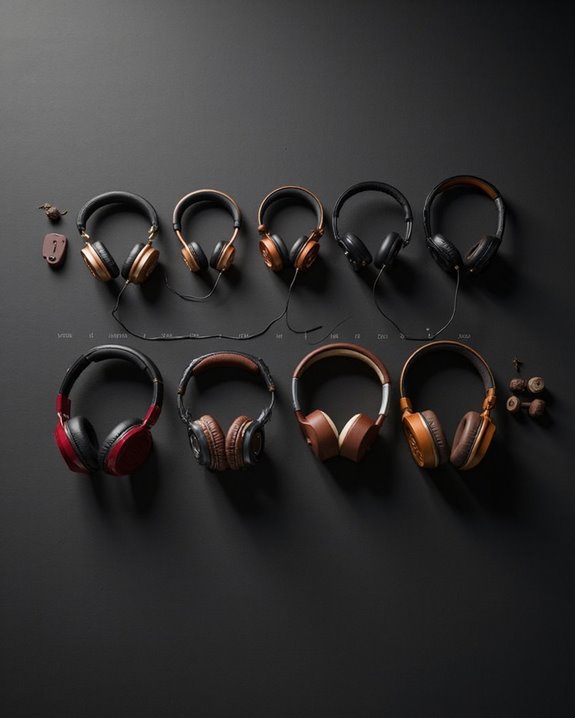
The evolution of headphone styles represents a fascinating journey through technological innovation and changing consumer needs. From the 1960s onward, manufacturers developed distinct designs to address various listening scenarios, with open-back models emerging in 1969 to improve sound quality.
The 1970s saw headphones adopted by musicians for stage monitoring, while 1989 marked Bose’s groundbreaking noise-canceling technology. Bone conduction headphones, introduced in 1994, expanded applications into hearing assistance devices.
Recent years have witnessed unprecedented diversification, with gaming headsets featuring advanced surround sound capabilities, truly wireless earbuds incorporating health monitoring functions, and high-end models offering spatial audio for immersive listening experiences. These specialized designs reflect how headphones have evolved beyond simple audio reproduction into multifunctional devices serving distinct market segments. Additionally, the development of bone conduction technology has allowed for open-ear designs that provide situational awareness and comfort during activities such as sports and swimming.
Wireless and Noise-Canceling: Game-Changing Technologies
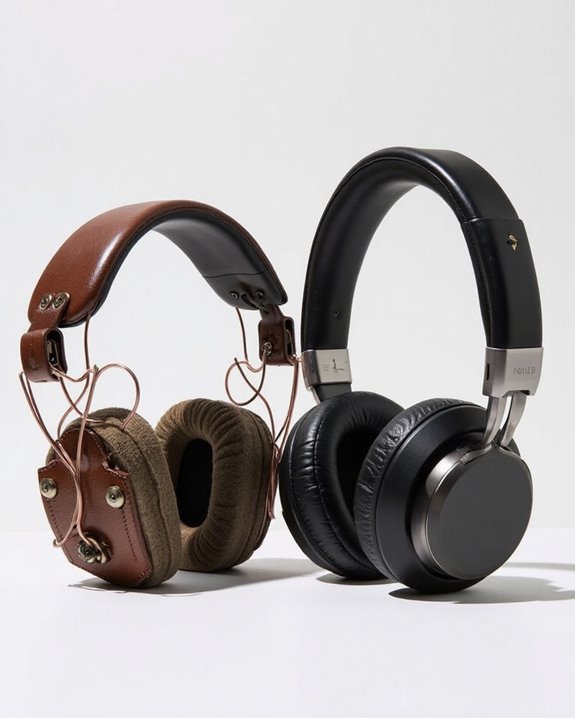
Technological liberation arrived for headphone users in the 1960s with the emergence of wireless designs, fundamentally altering how people experienced audio content. These early models utilized radio transmission technology, offering limited range but establishing the foundation for future wireless innovations.
The introduction of Bluetooth in the early 2000s created unprecedented Tech Synergy between headphones and various devices, accelerating market adoption and functionality. Modern wireless headphones support high-quality streaming and extended battery life, eliminating the constraints of wired connections.
Parallel developments in noise-canceling technology, pioneered in the 1950s for aviation, transformed headphones into tools for Audio Immersion. By generating inverse sound waves to neutralize ambient noise, these headphones create isolated listening environments. Today’s hybrid models combine active and passive noise-canceling methods, meeting diverse user needs from office work to commuting.
Leading models like the Sony WH-CH720N exemplify this advancement with features such as Dual Noise Sensor Technology and up to 35-hour battery life, enabling extended immersive listening experiences.
How Early Designs Shaped Today’s Headphone Industry
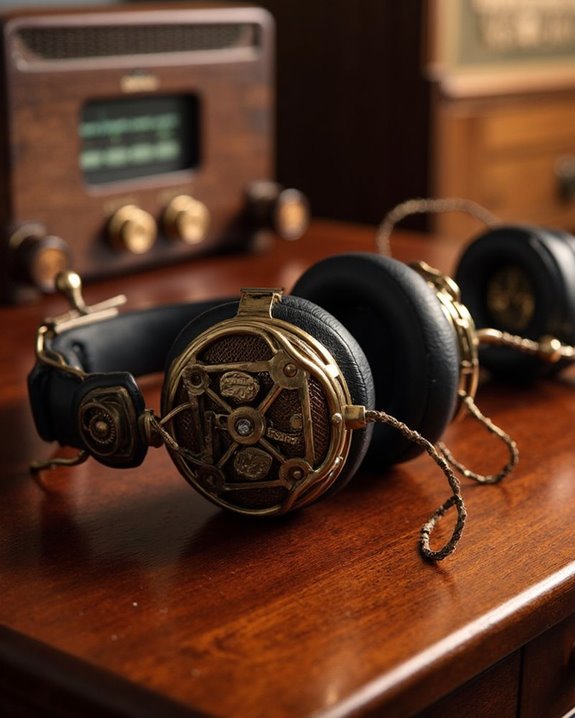
While modern users slip on streamlined wireless earbuds with intuitive touch controls, these innovations stand on the shoulders of pioneering designs dating back to the late 19th century. The evolution from Nathaniel Baldwin’s large cup headphones to Beyerdynamic’s DT-48 in 1937 established foundational principles still evident in contemporary models.
These early innovations drove the cultural impact of personal audio, transforming music consumption from communal to individual experiences. Today’s manufacturers, focused on ethical manufacturing practices, continue to reference designs like AKG’s K-120, which first balanced functionality with aesthetics in 1939.
Military applications during World War I accelerated development in sound isolation and communication technologies—advancements that directly influenced noise-canceling features found in premium contemporary headphones, demonstrating how historical engineering solutions continue to shape modern listening experiences. Modern headphones now incorporate advanced active noise cancelling technology that can reduce up to 98% of external noise for immersive audio experiences.
Frequently Asked Questions
How Did Headphones Impact Recording Studio Practices Throughout History?
Headphones revolutionized studio isolation, allowing musicians to monitor performances without audio bleed. They evolved from occasional use in the 1950s to essential tools that transformed mixing techniques, enabling more precise control over multi-track recordings.
What Materials Were Used in Early Headphone Manufacturing?
Like craftsmen sculpting sound from earth’s elements, early headphones relied on material innovations including wood, metal, and leather for component durability. Later, manufacturers incorporated cardboard, foam, rubber, and eventually plastics for improved comfort.
When Did Kids and Teenagers Become Major Headphone Consumers?
Teenagers emerged as significant headphone consumers in the 1970s-1980s when the Walkman revolutionized personal listening. Youth marketing strategies targeted teen preferences, expanding dramatically as portable music players became mainstream cultural phenomena among young people.
How Did Headphone Impedance Standards Develop Over Time?
Headphone impedance trends shifted from high (500+ ohms) for vacuum tube equipment to varied standards, including the controversial 120-ohm standard in 1996. Standards evolution continues with modern devices accommodating multiple impedance levels.
Which Cultures Adopted Headphones Earliest Outside Western Countries?
Surprisingly, less than 5% of historical headphone documentation covers Eastern Pioneers. Japan emerged as a leader in Asian Adoption, followed by urban centers in China and India during the early 20th century telecommunications expansion.

